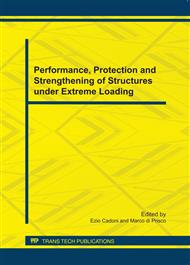[1]
A.H. Streland, A.H: Going Deep: A System Concept for Detecting Deeply Buried Facilities from Space. Research Report, Air War College, Air University, USA (2003).
DOI: 10.21236/ada424602
Google Scholar
[2]
J.T. Baylot: Parameters Affecting Loads on Buried Structures Subjected to Localized Blast Effects. Technical Report SL-92-9, Department of Army, Waterways Experiment Station, Corps of Engineers (1992).
Google Scholar
[3]
C.K. Gautam and R.C. Pathak, R.C (1997). Design of blast resistant structure. Defence Science Journal, Vol 47(1997), No. 2, pp.139-148.
DOI: 10.14429/dsj.47.3986
Google Scholar
[4]
W.W. McCarthy: Self-contained underground shelters for pre-positioned deployment for defense against NBC warfare. NBC Defense Collective Protection Conference Papers (2002).
Google Scholar
[5]
TM5-855-1: Fundamentals of Protective Design for Conventional Weapons. Dept. of the Army, Washington D.C, USA (1986).
Google Scholar
[6]
J.L. Drake, R.A. Frank and M.A. Rochefort: A simplified method for the prediction of the ground shock loads on buried structures. Proceedings of the International Symposium on the Interaction of Conventional Weapons with Structures, Mannheim, West Germany (1987).
Google Scholar
[7]
E.C. Leong, S. Anand, H.K. Cheong and C.H. Lim (2003). Response of buried structures subjected to below ground explosion. 11th International Symposium on Interaction of the Effects of Munitions with Structures, Germany.
Google Scholar
[8]
E.C. Leong, S. Anand, H.K. Cheong and C.H. Lim: Re-examination of peak stress and scaled distance due to ground shock. International Journal of Impact Engineering, Vol. 34 (2007), No. 9, p.1487 – 1499.
DOI: 10.1016/j.ijimpeng.2006.10.009
Google Scholar
[9]
The Survival Center, http://survivalcenter.com/UG.html (accessed 8 August 2008).
Google Scholar
[10]
R.H. Cole: Underwater Explosions. New York: Dover Publications (1965).
Google Scholar
[11]
S. Kobielak, T. Krauthammer, and A. Walczak: Ground shock attenuation on a buried cylindrical structure by a barrier. Shock and Vibration Vol. 14 (2007), p.305–320.
DOI: 10.1155/2007/162348
Google Scholar


